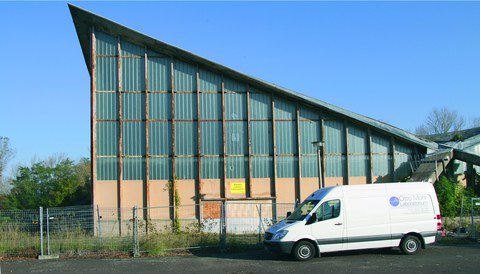Material test at a hypar shell
Table of contents
Project data
| Titel | Title Untersuchung eines Zugbandes bei der Hyparschale in Magdeburg | Examination of a tieback at the hypar shell in Magdeburg Förderer | Funding SGHG Ingenieurdiagnostik Bautechnik GmbH, Dresden Zeitraum | Period 10.2017 Leiter | Project Manager Prof. Dr.-Ing. Dr.-Ing. E.h. Manfred Curbach (Institut für Massivbau, TU Dresden), Bearbeiter | Contributors Dipl.-Ing. (FH) Sabine Wellner, Heiko Wachtel, Bernd Wehner |

Hypar shell Magdeburg
Report from the annual report 2017
The ‘Hyparschale’ is a multi-purpose hall in the city park ‘Rotehorn’ in Magdeburg. It was built in 1969 according to plans by Ulrich Müther. The four connected hyperbolic paraboloid shells, made of reinforced concrete, cover a floor space of approximately 2300 m². Therefore, it is the largest shell structure of Müther, which is still preserved today. The listed Hyparschale has been vacant for many years and is in a structurally poor condition today.In June 2017, the Magdeburg City Council decided to extensively renovate the building. As part of the preparation of the renovation, a comprehensive building exploration is required. Among others, the existing pre-tension in the prestressed foundation beams must be determined to assess the load bearing behaviour of the structure reliably.

Application of strain gauges
Intotal, there are four underground prestressed tiebacks which are arranged diagonally and take up a large part of the horizontal thrust of the roof structure from the inclined columns at the outer low points of the hyperboloid. They are therefore essential for the stability of the building. In 2017, the Otto Mohr Laboratory was asked to determine the actual prestressing force in one of the prestressed foundation beams. For this purpose, one tendon was uncovered at one point. After opening the cladding tube, two of the prestressing bars were exposed, and a strain gauge was applied to each of them. If the steels are severed (here: using angle grinders), it is possible to conclude from the subsequent relaxation in the prestressing steels, the approximate value of the existing prestressing force. The strain changes were recorded digitally. The obtained values are now used by the statics office for calculation and modelling.
The start of the renovation is scheduled in 2018. According to the current state, carbon reinforced concrete could be used as a strengthening method for beams or columns.

Cutting the prestressing steels
